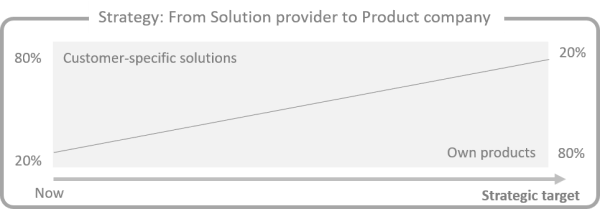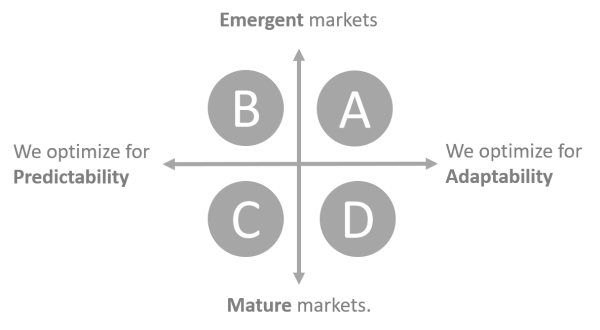This post is the first in a series of posts discussing the hypothetical company, Renewable Tech [RT]’s journey towards the vision of becoming a strong and undisputed market-leading Product company within renewables technology, from primarily being a provider of customer-specific solutions.

Context
This first post will primarily be used to set the scene e.g., describing the context within which RT operates.
RT and its customers
RT is a successful B-t-B company providing customer specific solutions to OEMs and operators in the Renewable Energy industry. One of the reasons behind RT’s undisputed success has been its strong and focused market strategy. RT knows that you cannot be successful unless you focus with active selection and equally important active decision on what not to target. Shoot at everything and you’ll end-up not hitting much. Focus within context is everything.
RT's processes supporting development of the customer-specific solutions
The current process framework governing the development and delivery of customer-specific solutions is optimized for predictability as illustrated in quadrant C – home for the classic project (find more on A-B-C-D here):

Over time the process model has become more and more prescriptive with e.g., a lot of check-lists and heavy governance. In addition, a large segment of RT’s OEM customers have formed a consortium with the purpose of standardizing the interface between the OEMs and its solution suppliers. This has added even more prescriptive processes to the model.
RT’s ability to operate in C, staying within the boundaries of the “project iron triangle”, is undisputed. In fact, it has an ISO 9001:2015 certification on its process consistency.
RT's management and strategy
RT’s strategy shifting focus to becoming a product company includes M&As and significant investments in innovation competences and capacity. In addition, RT is having a network of partners, including universities.
With a solid financial foundation and a long-term thinking owner group, RT has the perfect conditions to do the right things (in contrast having to please a short-term thinking private equity fund).
RT's products
RT’s products are (and especially will be) an innovative and multidisciplinary mix of electronics (high- and low power), hardware, mechanics and software (embedded, application, app, Machine Learning ..) with some services hosted in the Cloud. If not before, with the new vision becoming a strong and market-leading product company, RT cements that technology is the product.
RT has a global footprint with production facilities, adapting an increasing amount of “Industry 4.0” elements. As will become evident in coming posts, the implementation in production of innovated products is equally important as the product innovation itself. Elon Musk’s Tesla, or SpaceX for that matter, is a perfect example of this:
Elon Musk @Twitter May 3rd 2021
In fact, Musk took the credit away from the company’s (ed.: Tesla) range of electric vehicles in response to a tweet by investment firm Ark Invest, January 2021:
Companies with purely digital products do not have this added complexity. Using e.g., the latest advances in Cloud Serverless, its DevOps teams can minimize efforts spent on Operations.
RT's competitors and how to stay competitive
The market for renewable tech is big – very big – attracting global competition on the full spectrum from the niche startups to global heavy-weights. RT knows that the core differencing power is found in sustainable innovation. To quote the globally known Danish water-tech company, Grundfos, and their 2025 strategy (last page):
Grundfos 2025 strategy
One of RT’s challenges is thus to grow strength in quadrant A (see the illustration above – the home for product innovation) being fundamentally different in mindset and approach compared to quadrant C. In A focus is on creativity and hard thinking – not on C‘s process compliance.
Elon Musk
This will be a key area to discuss in the coming posts.
Sources of inspiration in this series of posts
Combined with my own practical experience and theoretical toolbox, this series of posts will seek guidance from the North Star provided by e.g., Marty Cagan, Teresa Torres, Gary Hamel, Matthew Skelton, John Doeer, Jeff Patton and others. This should give you some idea on the direction and mindset applied.
I’ll be assuming that RT’s employees already have a solid insight in and practical experience with the Scrum / Kanban frameworks (if not – get trained), and with the good old virtues of project management thus not spending much time on those basics.
I’ll also be assuming that solid engineering practices are in place in all technology areas.
The vision to become a strong market-leading high-tech Product company
RT has spent a considerable amount of time and effort collecting insights, testing hypothesis and formulating a compelling, motivating and ambitious vision. RT’s executive management is highly inspired by Jeff Bezos.
Stay tuned for the next post in this series discussing the vision.

